Committee Blog: The Importance of Feasibility Due Diligence Prior to Purchase of a Cannabis Facility
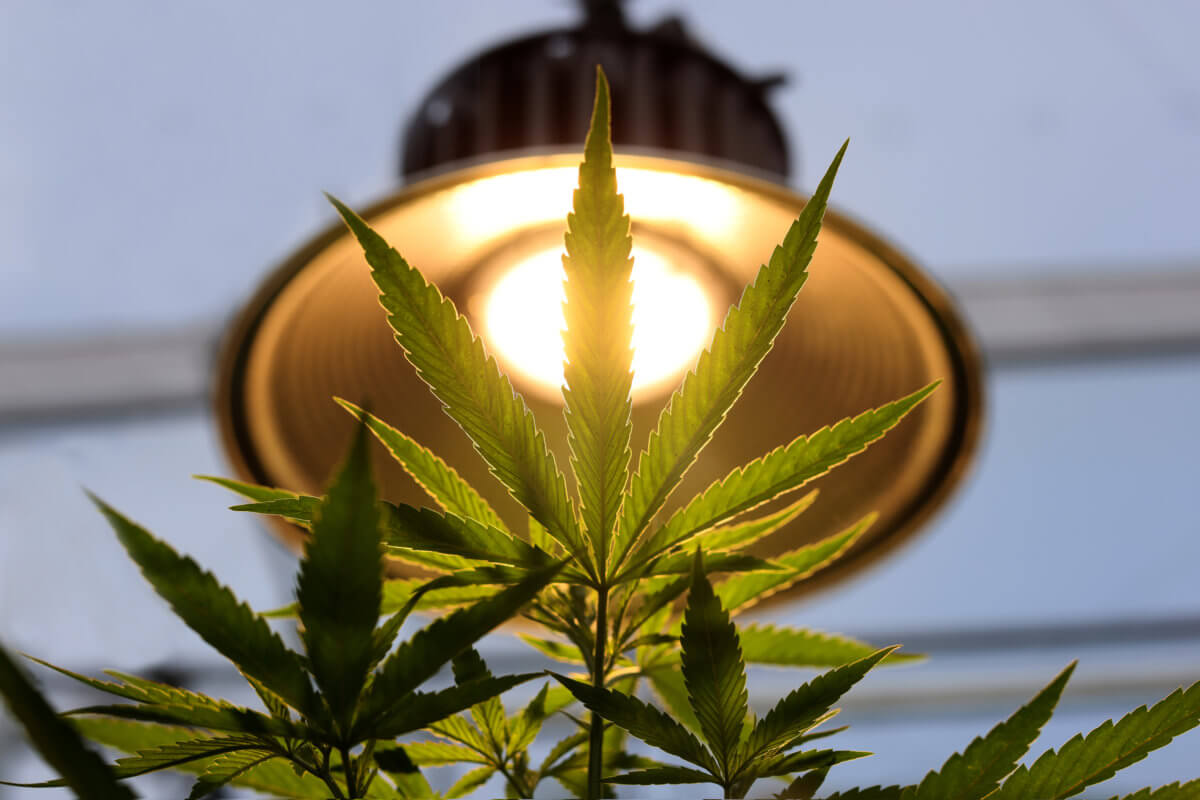
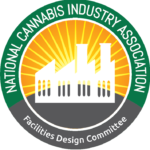 by Kathleen May, Sonny Antonio, Casey Rivero, David Vaillencourt
by Kathleen May, Sonny Antonio, Casey Rivero, David Vaillencourt
NCIA’s Facilities Design Committee
In our previous blogs, the Facility Design Committee authors emphasized the importance of defining facility layout and design components during the planning phase of facility purchase, infrastructure, and operational flow of processes and materials. This blog dives further into the often overlooked variables that we have seen significantly impact operational timelines, and in some cases send business owners back to the drawing board at considerable cost. These critical areas are the capacity of your utilities – specifically a) Electrical Facilities, b) Gas Facilities, and c) Phone and Cable.
ELECTRIC FACILITIES
Do you know how much power your operation will require and whether the facility and utilities are capable of supporting your requirement? Facilities should be designed to meet the electrical demands of equipment operation, lighting, and accurate functionality of HVAC systems. Processes and procedures should be designed according to the requirements outlined in the National Electrical Code (NEC), Institute of Electrical and Electronics Engineers (IEEE), National Electrical Safety Code (NESC), International Building Code (IBC), International Energy Conservation Code (IECC), and any other relevant standards dictated by the Authority Having Jurisdiction (AHJ).
Key questions to ask:
- Is the electric capacity adequate to support the operations planned in the facility?
-
- Is primary (main) and secondary (meter) power installed?
- Is there three (3) phase power?
-
- If three (3) phase is required, is it available?
- If it is not available, has the cost to supply the facility with three (3) phase been budgeted for?
-
- Does the local power company have the capacity to support the facility? Has there been discussion with the local power company to communicate capacity needs?
- If the capacity is not supported, is there an opportunity that it will be?
Why does this matter?
Cannabis operations, especially growing plants require a significant amount of electrical capacity and existing buildings were rarely designed to handle these requirements. Further, just because you see power lines nearby, this does not mean that they can magically handle whatever power requirements you need. Our national power grid has many limitations, and depending on the jurisdiction and local power authority may not have the resources to meet your needs.
What can I do?
If you aren’t absolutely certain that you have sufficient power capacity, assess the proposed location with a Subject Matter Expert (SME) and a representative from the local Power Company.
- Walking the site to confirm what has been verbally communicated is critical. Discrepancies are not uncommon.
GAS FACILITIES
The same types of questions that were asked for the Electrical Facilities should be asked when confirming gas facilities and capabilities. Key questions may include:
- Is the existing gas service adequate for the operations planned for the facility? Just like with electrical power – confirming the presence of a gas meter does not guarantee that the gas capacity is adequate for the operation.
- If upgrades are required or if a new gas line needs to be installed, have those costs been budgeted for?
Again, hiring a consultant with subject matter expertise in gas utilities, gas lines, and gas pressure would be beneficial when speaking with the local gas company.
PHONE and CABLE
While many across the country have ditched landlines in favor of cell phones, the same is far from true for new businesses, especially with the security requirements needed for a cannabis facility.
Are phone and cable required for the operation? If so, some key questions to consider are the following:
- What size and speed are required to support specific needs (i.e., security)?
- Is the existing wire large enough for my needs? If not, is it possible to get phone and cable to the site?
- Is satellite an option if phone and cable are unavailable?
- Have all costs been budgeted for?
Especially in rural or newly designated economic improvement zones, high-speed internet access may be limited. Service Level Agreements (SLAs) provide the assurance of minimum uptimes. A car crash into a nearby service line or other technical glitches can quickly put you out of compliance with 24/7 camera monitoring requirements, intrusion detection systems, and more. In many cases, it’s wise to consider redundancy from secondary providers where available.
In Conclusion…
Every site and facility is different and may or may not be sufficient for the overall operations planned. Site and facility capabilities should be assessed for each project and assumptions should not be made based on previous experience. Ask the critical questions upfront and invest in experts that understand these key components of facility layout and design. Proper planning will avoid project setbacks and unexpected obstacles, and will always save time and money.
The Facilities Design Committee focuses on providing NCIA members and regulators a framework and information about facilities design options through which legal producers can plan for GMP level production as the market transitions from a state to a federally regulated industry.
Committee Blog: Poor Project Planning – A Costly Mistake for Cannabis Entrepreneurs

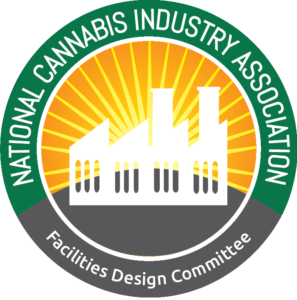 by NCIA’s Facilities Design Committee
by NCIA’s Facilities Design Committee
Facility layout and design are important components of overall operations, both in terms of maximizing the effectiveness and efficiency of the process(s) executed in a facility, and in meeting the needs of personnel. Prior to the purchase of an existing building or investing in new construction, the activities and processes that will be conducted in a facility must be mapped out and evaluated to determine the appropriate infrastructure and flow of processes and materials. In cannabis markets where vertical integration is the required business model, multiple product and process flows must be incorporated into the design and construction. Materials of construction and critical utilities are essential considerations if there is the desire to meet Good Manufacturing Practice (GMP) compliance or to process in an ISO certified cleanroom.
All these activities require a well-thought-out and documented project plan. Unfortunately, many cannabis entrepreneurs that embark on the journey into the industry fail to properly plan, and furthermore fail to understand that proper project planning is the most critical stage of the entire project. Inadequate planning is the primary reason projects spin out of control, take longer to execute, cost more money, and ultimately fail. Proper and effective project planning involves comprehensive mapping and organizing of project objectives and goals, identifying tasks and deliverables, maintaining schedules, proper allocation of resources, and defining roles and responsibilities of team members before the project even gets off the ground. Most problems that lead to project failure can be avoided with proper project planning.
Why is project planning so important? The answer is simple. Proper project planning:
- Ensures project performance and success.
- When tasks, deadlines, deliverables, and responsibilities are defined upfront, there is a better chance the project will run smoothly, efficiently, and be successful.
- Saves money (and keeps investors happy).
- Failed projects are expensive. Rework and delays may lead to project scope creep which subsequently leads to going over budget and missing deadlines.
- Improves team communication.
- When everyone is on the same page and understands the objectives and expectations, projects are effective and timely. Routine team meetings to discuss potential roadblocks to deadlines are key to a project’s success.
- Ensures resources are properly allocated.
- Identifying team members with the appropriate skillsets to lead and manage the various aspects of a project is critical to the success of the project. Assigning an overall project manager is highly recommended.
- Project status is tracked and documented.
- Documenting target dates, deliverables, and metrics is critical for keeping a project on track. This allows everyone to be aligned and informed on tasks, timelines, expectations, and workflow.
There are several considerations when designing a cannabis operation, whether it is a grow room or a product manufacturing facility. Regardless of what type of facility is needed or desired, applicable local, federal, and international regulations and standards must be reviewed to ensure proper design, construction, and operation, as well as to guarantee the safety of employees.
Materials of Construction
The materials of construction for interior work surfaces, walls, floors, and ceilings should be fabricated of non-porous, smooth, and corrosive resistant surfaces that are easily cleanable to prevent harboring of microorganisms and damage from chemical residues. Flooring should also provide wear resistance, stain, and chemical resistance for high traffic applications. Interior and exterior (including the roof) materials of construction should meet the requirements of the International Building Code (IBC), the National Fire Protection Association (NFPA), Occupational Safety and Health Administration (OSHA), and other applicable building and safety standards, particularly when the use, storage, filling, and handling of hazardous materials occurs in the facility.
Utilities
Critical and non-critical utilities need to be considered in the initial planning phase of a facility build out. Critical utilities are the utilities that when used have the potential to impact product quality. These utilities include water systems, Heating Ventilation and Air Conditioning (HVAC), compressed air, and pure steam. Non-critical utilities may not present a direct risk to product quality, but are necessary to support the successful, compliant, and safe operations of a facility. These utilities include electrical infrastructure, lighting, fire detection and suppression systems, gas detection, and sewage.
Water quality, both chemical and microbial, is a fundamental and often overlooked critical parameter in the design phase of cannabis operations. Water is used to irrigate plants, for personnel handwashing, potentially as a component in compounding/formulation of finished goods, and for cleaning activities. Water quality should be tested and monitored to ensure compliance to microbiological and chemical specifications based on the chosen water type, the intended use of the water, and the environment in which the water is used. Overall water usage must be considered during the facility design phase. In addition to utilizing water for irrigation, cleaning, product processing, and personal hygiene, water is used for heating and cooling of the HVAC system, fogging in pest control procedures, and in wastewater treatment procedures. A facility’s water system must be capable of managing the amount of water required for the entire operation. Water usage and drainage must meet environmental protection standards. State and local municipalities may have water usage limits, capture and reuse requirements, and regulations regarding runoff and erosion control that must also be considered as part of the water system design.
Lighting considerations for a cultivation facility are a balance between energy efficiency and what is optimal for plant growth. The preferred lighting choice has typically been High Intensity Discharge (HID) lighting, which includes metal halide (MH), and high-pressure sodium (HPS) bulbs. However, as of late, light-emitting diodes (LED) systems are gaining popularity due to increased energy saving possibilities and innovative technologies. Adequate lighting is critical for ensuring employees can effectively and safely perform their job functions. Many tasks performed on the production floor or in the laboratory require great attention to detail. Therefore, proper lighting is a significant consideration when designing a facility.
Environmental factors, such as temperature, relative humidity (RH), airflow, and air quality, play a significant role in maintaining and controlling cannabis operations. A facility’s HVAC system has a direct impact on cultivation and manufacturing environments, and HVAC performance may make or break the success of an operation. Sensible heat ratios (SHRs) may be impacted by lighting usage and RH levels may be impacted by the water usage/irrigation schedule in a cultivation facility. Dehumidification considerations are critical to support plant growth and vitality, minimize microbial proliferation in the work environment, and to sustain product shelf-life/stability. All of these factors must be evaluated when commissioning an HVAC system. HVAC systems with monitoring sensors (temperature, RH, and pressure) should be considered. Proper placement of sensors allows for real-time monitoring and a proactive approach to addressing excursions that could negatively impact the work environment.
Compressed air is another, often overlooked, critical component in cannabis operations. Compressed air may be used for a number of applications, including blowing off and drying work surfaces and bottles/containers prior to filling operations, and providing air for pneumatically controlled valves and cylinders. Common contaminants in compressed air are nonviable particles, water, oil, and viable microorganisms. Contaminants should be controlled with the use appropriate in-line filtration. Compressed air application that could impact final product quality and safety requires routine monitoring and testing.
- Electrical Infrastructure
Facilities should be designed to meet the electrical demands of equipment operation, lighting, and accurate functionality of HVAC systems. Processes and procedures should be designed according to the requirements outlined in the National Electrical Code (NEC), Institute of Electrical and Electronics Engineers (IEEE), National Electrical Safety Code (NESC), International Building Code (IBC), International Energy Conservation Code (IECC), and any other relevant standards dictated by the Authority Having Jurisdiction (AHJ).
- Fire Detection and Suppression
Proper fire detection and suppression systems should be installed and maintained per the guidelines of the National Fire Protection Association (NFPA), International Building Code (IBC), International Fire Code (IFC), and any other relevant standards dictated by the Authority Having Jurisdiction (AHJ). Facilities should provide standard symbols to communicate fire safety, emergency, and associated hazards information as defined in NFPA 170, Standard for Fire Safety and Emergency Symbols.
Processes that utilize flammable gasses and solvents should have a continuous gas detection system as required per the IBC, Chapter 39, Section 3905. The gas detection should not be greater than 25 percent of the lower explosive limit/lower flammability limit (LEL/LFL) of the materials. Gas detection systems should be listed and labeled in accordance with UL 864, Standard for Control Units and Accessories for Fire Alarm Systems and/or UL 2017, Standard for General-Purpose Signaling Devices and Systems and UL 2075, Standard for Gas and Vapor Detectors and Sensors.
Product and Process Flow
Product and process flow considerations include flow of materials as well as personnel. The classic product and process flow of a facility is unidirectional where raw materials enter on one end and finished goods exit at the other. This design minimizes the risk of commingling unapproved and approved raw materials, components, and finished goods. Facility space utilization is optimized by providing a more streamlined, efficient, and effective process from batch production to final product release with minimal risk of errors. Additionally, efficient flow reduces safety risks to employees and an overall financial risk to the organization as a result of costly injuries. A continuous flow of raw materials and components ensures that supplies are available when needed and they are accessible with no obstructions that could present a potential safety hazard to employees. Proper training and education of personnel on general safety principles, defined work practices, equipment, and controls can help reduce workplace accidents involving the moving, handling, and storing of materials.
Facilities Management
Facilities management includes the processes and procedures required for the overall maintenance and security of a cannabis operation. Facilities management considerations during the design phase include pest control, preventative maintenance of critical utilities, and security.
A Pest Control Program (PCP) ensures that pest and vermin control is carried out to eliminate health risks from pests and vermin, and to maintain the standards of hygiene necessary for the operation. Shipping and receiving areas are common entryways for pests. The type of dock and dock lever used could be a welcome mat or a blockade for rodents, birds, insects, and other vermin. Standard Operating Procedures (SOPs) should define the procedure and responsibility for PCP planning, implementation, and monitoring.
Routine preventative maintenance (PM) on critical utilities should be conducted to maintain optimal performance and prevent microbial and/or particulate ingress into the work environment. Scheduled PMs may include filter replacement, leak and velocity testing, cleaning and sanitization, adjustment of airflow, the inspection of the air intake, fans, bearings, and belts, and the calibration of monitoring sensors.
In most medical cannabis markets an established security program is a requirement as part of the licensing process. Facilities should be equipped with security cameras. The number and location of the security cameras should be based on the size, design, and layout of the facility. Additional cameras may be required for larger facilities to ensure all “blind spots” are addressed. The facility security system should be monitored by an alarm system with 24/7 tracking. Retention of surveillance data should be defined in a Standard Operating Procedure (SOP) per the AHJ. Motion detectors, if utilized, should be linked to the alarm system, automatic lighting, and automatic notification reporting. The roof area should be monitored by motion sensors to prevent cut-and-drop intrusion. Daily and annual checks should be conducted on the alarm system to ensure proper operation. Physical barriers such as fencing, locked gates, secure doors, window protection, and automatic access systems should be used to prevent unauthorized access to the facility. Security barriers must comply with local security, fire safety, and zoning regulations. High security locks should be installed on all doors and gates. Facility access should be controlled via Radio Frequency Identification (RFID) access cards, biometric entry systems, keys, locks, or codes. All areas where cannabis raw material or cannabis-derived products are processed or stored should be controlled, locked and access restricted to authorized personnel. These areas should be properly designated “Restricted Area – Authorized Personnel Only.”
Future Expansion
The thought of expansion in the beginning stages of facility design is probably the last thing on the mind of the business owner(s) as they are trying to get the operation up and running, but it is likely the first thing on the mind of investors if they happen to be involved in the business venture. Facilities should be designed so that they can be easily expanded or adjusted to meet changing production and market needs. Thought must be given to how critical systems and product and process flows may be impacted if future expansion is anticipated. The goal should be to minimize downtime while maximizing space and production output. Therefore, proper up-front planning regarding future growth is imperative for the operation to be successful and maintain productivity while navigating through those changes.
Member Blog: Commercial Property Assessed Clean Energy (C-PACE) – A Competitive Funding Source for the Cannabis Industry

by Dr. Teresa Smith, Ebee Management Group
The state-by-state level of legalization and expansion of cannabis continues to pick up momentum across the United States, however, the adoption at Federal level is a much slower movement. The absence of federal legalization has created a situation where federally insured lending institutions like banks and traditional investment capital markets are prohibited from funding cannabis projects. The direct result of this restriction in capital has historically forced the cannabis industry to rely exclusively on private loans and individual investors as the primary sources of development and operating capital. These sources of capital are limited in capacity and can garner interest rates from 15-25%. While the legalized cannabis industry has made great strides in removing much of the negative stigma surrounding the products and their uses, resulting in the opening of some additional funding sources such as crowdfunding and angel investors, the cost of these capital sources is still significantly above the conventional market rates. At Ebee Management Group, we would argue that the most underutilized yet best financing tool presently available for the cannabis industry is the Commercial Property Assessed Clean Energy (C-PACE).
C-PACE is an innovative financing tool that gives owners of commercial, industrial, and multi-family properties access to long-term fixed-rate financing for energy efficiency, water conservation, and renewable energy projects. The C-PACE legislation authorizes municipalities or counties to partner with private capital providers to deliver financing options to commercial property owners for energy qualified improvements with the collection of the debt repayment through a special assessment on the property’s tax bill. The C-PACE funds provide upfront capital with 100% financing for qualified improvement often with terms up to 20 years. The resulting energy savings and reduced operating and maintenance costs typically exceed the amount of the assessment payment and often contribute to a positive cash flow to the operating budget.
The primary caveat to the use of C-PACE for cannabis is that the property must be in a state that has passed the legislation that empowers local municipalities to provide C-PACE as a funding tool. C-PACE can be funded directly by the municipality through a bond issuance; however, most projects are presently being funded by the private equity markets. Typical terms on a C-PACE-funded cannabis transaction are 100% financing, fixed for a term up to 20 years at interest rates ranging from 7%to 9%. The maps below illustrate the current enactment of state-level policy for both cannabis and PACE.
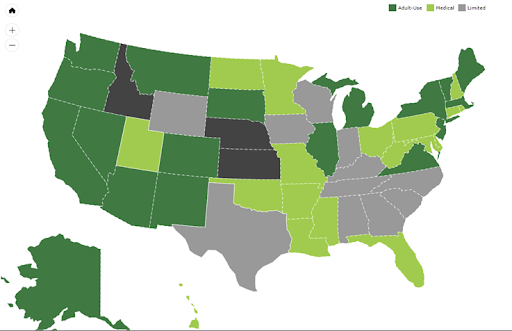
Map provided and maintained on the NCIA website
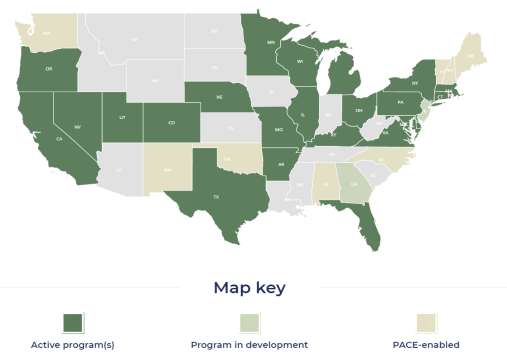
Map provided and maintained on the PACENation website
C-PACE can be utilized for any improvement that saves energy with maximum lending limits influenced by individual state legislation and program guidelines. Typically, the maximum loan amount is capped at 20-25% of the completed appraised value and restricted to funding only qualifying improvements. Typical qualified improvements include lighting, HVAC systems, and building controls, doors, windows, roofs, and alternative power generation like wind and solar. PACE can be used for retrofitting an existing building, new construction, and in some states, refinance of existing debt. For the established cannabis market, the refinance option is an extremely attractive tool because it can be utilized to pay off higher-cost investor debt and is non-recourse to the owner. The debt is tied to the physical facility as a special assessment, not a mortgage lien, and is thus fully transferable at sale. You heard me right. If you have a short-term hold strategy for a facility, any remaining obligation you have associated with your PACE assessment does not have to be paid off at closing. The balance of the debt follows the tax bill and transfers directly to the new owner like any other existing tax-based assessment.
The table below outlines the benefits and features of C-PACE
| Owner Benefits |
Financing Features |
Qualified Equipment |
| • Lower cost capital
• Non-recourse to owner
• Preserves owner’s capital
• Debt transfers at sale |
• 100% financing of qualified improvements
• Long-term fixed-rate up to 20 years
• Competitive interest rates ranging from 6.5%-9.5%
• Debt securitized by a special assessment on the property |
• Lighting
• HVAC
• Controls
• Roofs
• Doors & Windows
• Insulation
• Power factor conversion
• Alternative energy generation |
The future of a wider array of funding options for the cannabis industry will clearly be impacted by both the ongoing adoption on a state-level and the possible federal-level legalization. Presently the pressure from states like New York and Chicago that house the two largest capital markets in the United States is leading to the expanded conversations about tapping into some of these sources of capital. That being said, arguably the best real-time solution for structuring a cannabis capital stack is C-PACE. New construction, building retrofit, or refinance, C-PACE can fill a gap or serve as a lower-cost replacement of other investment capital or equity.
 Dr. Teresa Smith leads the Strategic Growth & Development for Ebee Management Group where she is recognized as an industry expert in sustainable development, leveraging PACE financing solutions for qualified energy efficiency projects throughout Ohio and Michigan. Prior to joining Ebee in 2019, Teresa was the Business Development Manager for the Toledo-Lucas County Port Authority where she built a robust growth process that delivered a 280% annualized increase in Property Assessed Clean Energy (PACE) loan transactions, driving loan balances from $3 million in 2011 to $47 million in 2019. Teresa obtained a Bachelor Degree in Economics from Eastern Michigan University, a MBA in Executive Management from the University of Toledo and a Doctorate Degree in Business Management with a specialty in Leadership from Capella University.
Dr. Teresa Smith leads the Strategic Growth & Development for Ebee Management Group where she is recognized as an industry expert in sustainable development, leveraging PACE financing solutions for qualified energy efficiency projects throughout Ohio and Michigan. Prior to joining Ebee in 2019, Teresa was the Business Development Manager for the Toledo-Lucas County Port Authority where she built a robust growth process that delivered a 280% annualized increase in Property Assessed Clean Energy (PACE) loan transactions, driving loan balances from $3 million in 2011 to $47 million in 2019. Teresa obtained a Bachelor Degree in Economics from Eastern Michigan University, a MBA in Executive Management from the University of Toledo and a Doctorate Degree in Business Management with a specialty in Leadership from Capella University.
Ebee Management Group is a full-cycle construction, finance, and energy management firm, offering our clients the most cost-effective and appropriate development strategies — never compromising integrity and quality. We oversee every aspect of the project with a proprietary process and unique energy financing programs, delivering a custom designed, state-of-the-art energy savings solution with a guarantee to save you time, energy, and money. Ebee offers a wide array of financing solutions for the Cannabis Industry that reduce equity requirements and replace much more expensive sources of capital. Our flagship financing tool for new construction, renovation and refinance of commercial facilities is Commercial Property Assessed Clean Energy (C-PACE). This financing tool makes it possible for owners and developers of commercial properties to obtain low-cost, non-recourse, long-term financing which is paid back through an annual assessment on the organization’s property tax bill. For more information, contact Teresa Smith at 419.340.0420, tsmith@ebeeco.com or visit our website at https://www.ebeeco.com/
Member Blog: Strategies to Reduce Indoor Cultivation Facility Energy Costs
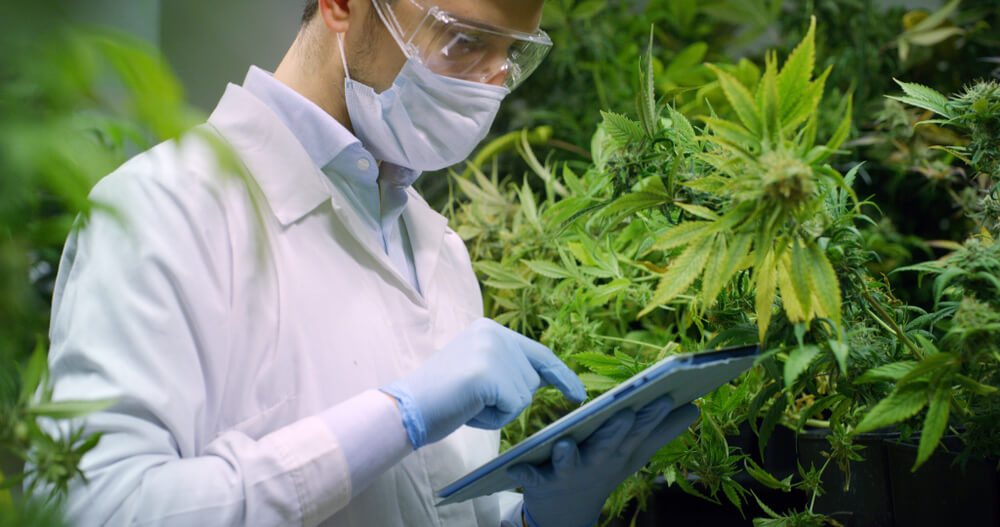
by Jason Magnuson of Mintropy
Indoor cannabis cultivation facilities are complex environments, where a large number of variables interact to create an ideal ecosystem to grow cannabis. The upside of an indoor facility is it allows a year-long growing climate, optimized for each stage of the plant grow cycle. The downside, however, is creating this ideal climate is very energy-intensive.
The total energy costs for indoor cannabis grow operations typically vary between 20%-50% of total operating costs (approximately 120-150 kWh/sq.ft). In comparison, energy use in a typical commercial building environment is approximately 25 kWh/sq. ft. As indoor cultivation facilities increase, they can be a source of strain on electrical grids. A recent study showed indoor cannabis cultivation alone accounted for 4% of the energy grid usage in Denver. (IEEE, 2020)
With that context, any areas we can identify to improve energy efficiencies without introducing a negative impact to the grow environment can have enormous bottom-line impacts for cultivation owners and society at large.
In this article, we are going to be examining two ways we can optimize HVACD systems to improve energy efficiency. When HVACD systems are designed for grow facilities, the primary variables we are looking to influence are the following psychrometric properties: temperature (either wet or dry bulb) and relative humidity. Mechanical engineers will often refer to an information-packed graph called a psychrometric chart shown below.
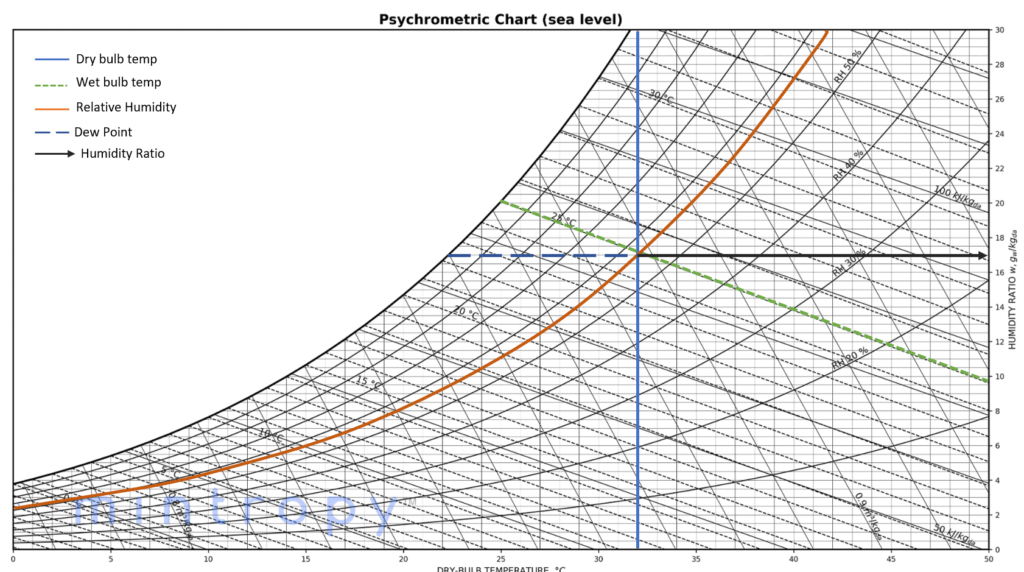
This chart helps to visualize the relationships different properties of air like temperature, humidity (relative and absolute) and dew points along the saturation curve have with each other. This is useful to analyze, as these are direct inputs to a scientific measure often favored by growers called Vapor Pressure Deficit (VPD).
Vapor Pressure Deficit, simply described, compares these variables to determine how much additional room for water vapor there is in the air. This is important as it determines how well cannabis plants can transpire. Controlling transpiration rates help to aid in healthy, robust growth through the plant life cycle. Growers tend to want lower VPD, and thus lower transpiration, early in plant maturity, and increase to higher VPDs, and thus high transpiration, at the flowering stage before harvesting.
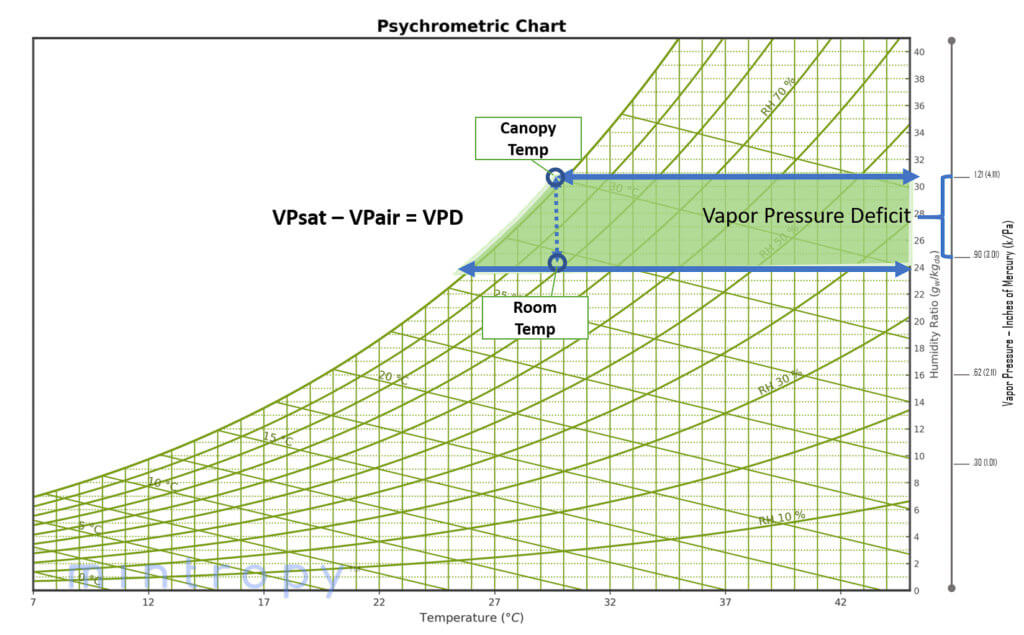
So we know a successful indoor cultivation facility HVAC system will need to control temperature and humidity to ensure the desired VPD values. How can we do that efficiently?
Stand-Alone Dehumidifiers Are Inefficient
A cannabis plant can transpire up to 99% of the water absorbed through its roots. Due to this, we often tell people that designing an Indoor Cultivation Facility is like designing a Data Center with a swimming pool inside. Because of the increased humidity introduced from plant transpiration, we must pay special attention to dehumidification strategies within the grow space. Humid air requires treating significant latent loads in the grow space, requiring additional energy to remove moisture from the airstream. This is one reason HVACD systems can consume up to 50% of the energy budget in a cultivation facility. As previously mentioned, higher humidity levels will lower the VPD in the room, preventing a plant from transpiring effectively to continue healthy growth. To combat this, sometimes stand-alone dehumidifiers are added into the grow room.
While these units can do the job of removing moisture from the room, it is a very energy-intensive process. One of the issues with stand-alone dehumidifiers is that they reject heat back into the grow room, thereby adding additional cooling load onto the main HVAC equipment.
Integral Hot Gas Bypass System
An air handling unit, sometimes called an air handler or AHU, is a piece of equipment that is used to condition and circulate air as a component of a heating, ventilating, and air conditioning system.
The air handler is usually a large metal box that contains a blower, heating and cooling elements, filter chambers, sound attenuators, and dampers. It then connects to ductwork that distributes the conditioned air throughout the space before returning it back to the AHU.
Of particular interest are the units cooling coil and reheat coil. These two components are namely responsible for controlling VPD levels in our grow space. In an Integral Hot Gas Reheat AHU, the cooling coil serves as a dehumidifier, by cooling the air thereby reducing its moisture/latent load (we highly recommend capturing this water for treatment and reuse: read more here). The hot gas reheat capability utilizes heat from grow space and compressor heat to reheat the air before returning to the grow space (without using additional heating energy).
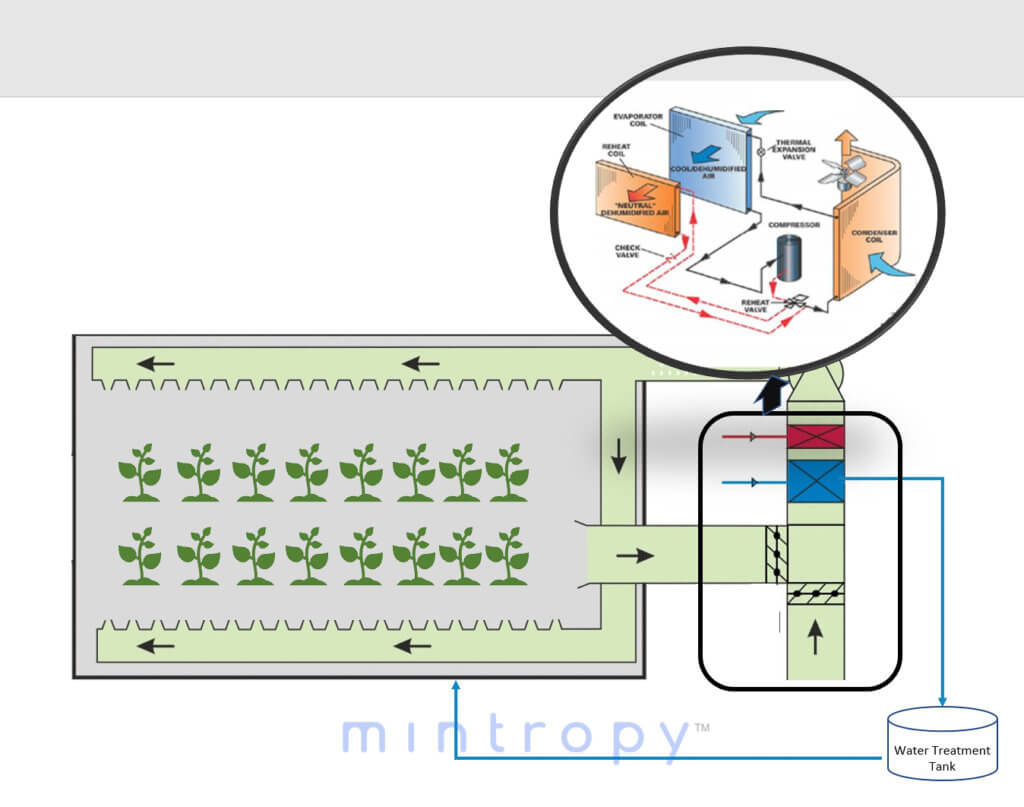
While this may seem like a minor design change, it results in a considerable reduction in energy. As the chart below illustrates, leveraging the Integral Hot Gas Bypass AHU units can result in a 30-35% reduction in HVACD energy when compared with other dehumidification systems. Additional automation capabilities built-into these systems will ensure that the grow room will remain tightly controlled within the desired state points of your grow room to optimize VPD.
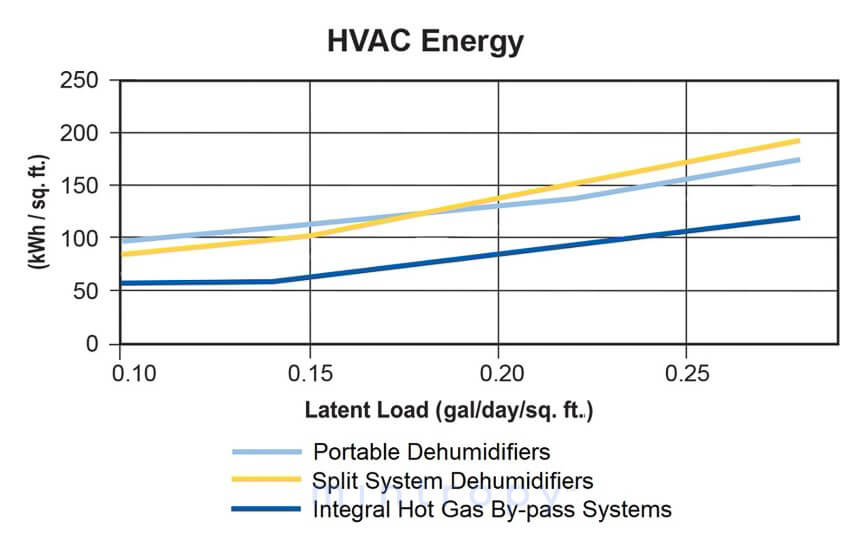
This reduction in energy quickly adds up to reduced utility bills. Despite marginally higher upfront costs as compared to standard HVAC equipment coupled with standalone dehumidifiers, this option results in a lower 5-year system cost than common HVACD systems installed in cultivation facilities, and these savings will only increase over time.
Maintaining Consistent VPD, but at higher Temperature / Humidity Ranges
The second energy-saving measure we would like to discuss goes back to the earlier discussion of VPD. Recall the equation for VPD is
V P sat – V P air = VPD
This is important, as it provides growers the flexibility to fall within desired VPD ranges, but at higher temperature and humidity ranges than typically used. Many growers target maximum temperatures around 70-75F and limit relative humidity to a maximum of 50 percent, but by allowing slightly higher maximum room temperatures of 75-80F, with corresponding relative humidity increases, we can create identical VPDs. The cost-benefit of this small adjustment is considerable. The HVAC system (including cooling and dehumidification) can be sized at roughly 20-30% smaller capacity, reducing the grower’s up-front equipment costs. In addition, the system’s energy consumption and costs during operations will be significantly lower, to the tune of 30-40%. In a theoretical 30,000 square foot facility, this could result in a $1,300,000 savings in the first 5 years.
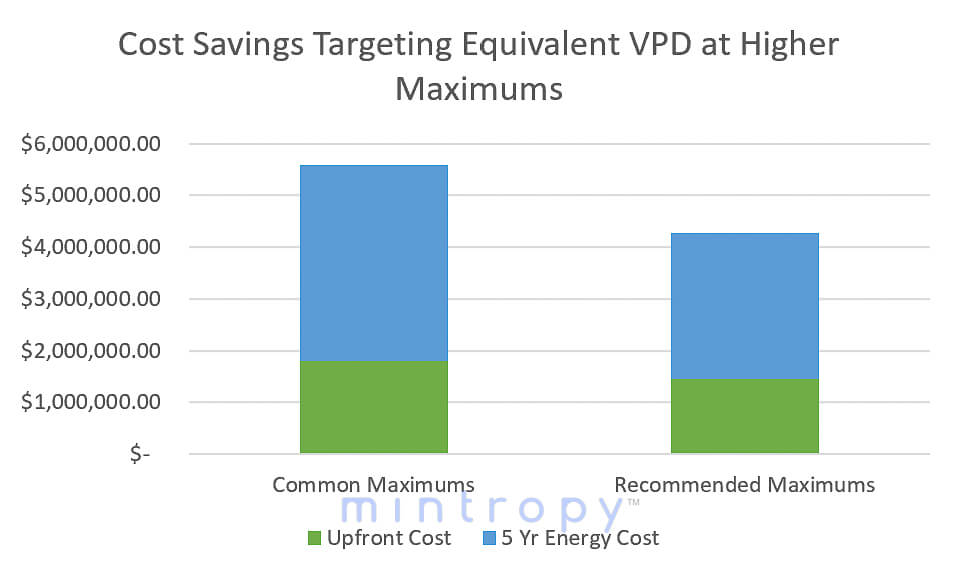
 Jason Magnuson is the Director of Business Development at mintropy. Mintropy is an MEP (Mechanical, Electrical, Plumbing) Engineering Design firm, with a focus on Indoor Cultivation Facility and Dispensary design. At mintropy, we strive to minimize entropy (minimize disorder) in building systems, by creating innovative and efficient designs to meet our client’s needs. For assistance in your cultivation facility, be it auditing/upgrading existing systems or designing new, reach out to us today.
Jason Magnuson is the Director of Business Development at mintropy. Mintropy is an MEP (Mechanical, Electrical, Plumbing) Engineering Design firm, with a focus on Indoor Cultivation Facility and Dispensary design. At mintropy, we strive to minimize entropy (minimize disorder) in building systems, by creating innovative and efficient designs to meet our client’s needs. For assistance in your cultivation facility, be it auditing/upgrading existing systems or designing new, reach out to us today.
Committee Blog: An Introduction to HVACD for Indoor Plant Environments – Why We Should Include a “D” for Dehumidification
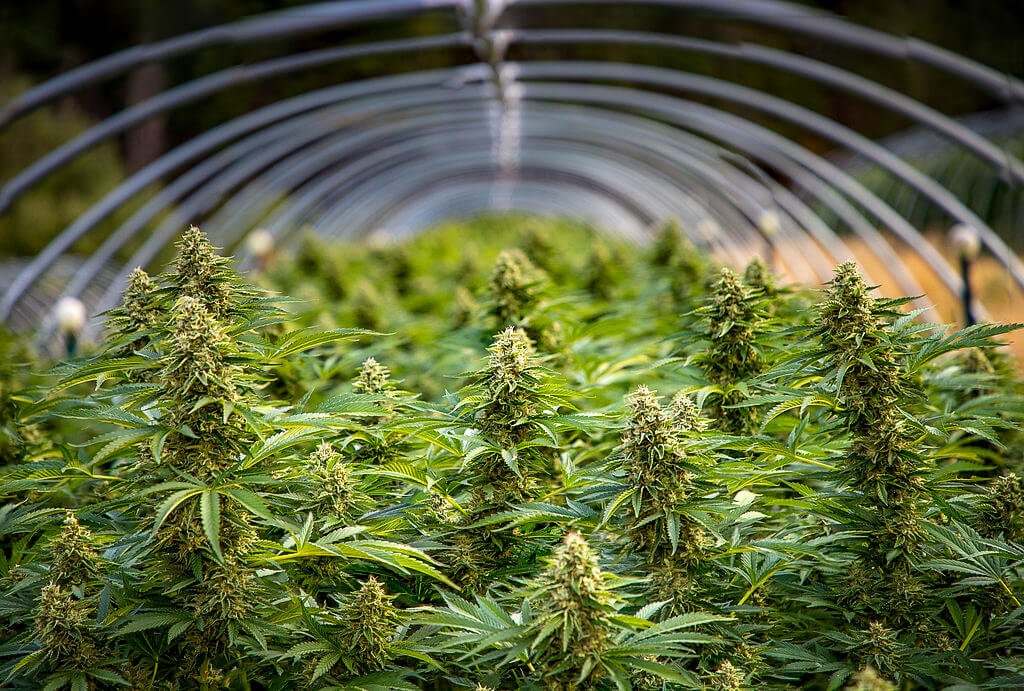
by NCIA’s Facilities Design Committee
Transpiration and VPD are two fundamental components of plant vitality, and heating, ventilation, and air conditioning (HVAC) systems are one of the most critical considerations for an indoor cannabis cultivator. HVAC alone doesn’t tell the full story of environmental control for cultivation facilities. The term HVAC is typically used to refer to the cooling, heating, or ventilation systems in a building, and while it technically includes dehumidification in most forms, it does not directly highlight the significant dehumidification requirements necessary to maintain optimum plant health inside indoor cultivation spaces. In order to emphasize the importance of dehumidification in the mechanical equipment sizing and selection process, the controlled environment horticulture industry would benefit from moving toward the concept of heating, ventilation, air conditioning, and dehumidification (HVACD) as the common term for these systems.
“HVAC” Challenges
The term HVAC is typically used to reference conventional air conditioning and heating systems designed for temperature control to provide a comfortable environment for people. This is clearly demonstrated in the very design of these systems – for example, sensible heat ratios of commercial HVAC equipment are pretty high in order to meet the loads generated by people, lighting, and miscellaneous equipment found in offices. Plants grown in enclosed spaces have different needs than people do. Of particular interest is the large amount of dehumidification that needs to be performed on a daily basis to maintain an optimum vapor pressure deficit (VPD).
When you apply a standard HVAC system to indoor horticulture, the instant the sensible load is removed from the space (i.e. the lights turn off), the air conditioning unit reaches the lower deadband of the specified temperature set point and shuts off. In the process of bringing the temperature down, we have raised the relative humidity to the detriment of the plants. Further, despite being mostly sensible cooling machines, conventional HVAC systems provide most of the dehumidification capacity in an indoor cultivation space, and that capacity is now inactive during the dark period.
Traditionally, growers would install stand-alone, pocket dehumidifiers to handle the moisture removal requirements that the air conditioning units cannot meet. There are a handful of challenges with this approach that can negatively impact plant health when scaling into industrial-scale operations. Most standalone dehumidifiers dry the air with mechanical refrigeration and in the process add hot air into the room, which then needs to be cooled by additional cooling equipment to maintain temperature. Another challenge is the numerous condensate drains throughout the growing space that are high risk for clogging and quickly leading to pest and pathogen proliferation which are potential GMP and GFSI compliance risks. The separate cooling and dehumidification systems typically do not have communication and control amongst them and ultimately “fight” against each other for temperature and relative humidity setpoints. Additional pest vectors can come into play when the HVAC contractor enters the cultivation or curing space to make repairs on mechanical equipment that is mounted above plants. Above all, maintaining cleanliness in the space can be challenging with many mechanical units perched above a dynamic plant canopy.
Dehumidification, or removing humidity from a room that is filled with water vapor as a result of plant transpiration, is arguably the biggest environmental challenge in controlled environment horticulture. When you size an HVAC system for human comfort or server rooms, the primary focus is temperature control (or sensible load). When selecting and sizing an HVACD system for plants to thrive, it’s all about the latent load, plant transpiration and VPD. Excess humidity is roughly twice as difficult to remove as excess heat from lights, so an effective system needs to be designed as a dehumidifier first and an air conditioner second. Integrated dehumidification needs to be at the beginning of every HVAC conversation, and a primary focus of every system.
The benefits of including dehumidification as a critical component
To maximize plant vitality, two fundamental components to understand are transpiration and VPD. Put simply, VPD is the humidity difference (or deficit) between the inside of a leaf and the environmental conditions surrounding that leaf. It is this humidity difference that draws water from the roots of a plant, through the stem and out of the leaf tissue, otherwise known as transpiration. This process is critical to photosynthesis and optimizing plant production, and it’s all directly related to the levels of humidity in a given room. As humidity is drawn out of the leaf, dehumidification must be used to remove the humidity from the environment and maintain appropriate VPD levels. Without dehumidification, humidity builds inside the room, plant growth and plant health are negatively impacted, and conditions become ideal for pests and pathogens.
Properly-designed dehumidification creates consistent and precise environmental conditions across the plant canopy, mitigating risk against issues like powdery mildew and botrytis. Well-executed dehumidification allows growers to control their VPD and drive plant health. At the end of the day, a stable climate sets a strong foundation of cultural control for a facility to maximize quality biomass while limiting crop loss associated with pest and pathogen issues.
Why does this all matter? Because properly sized and commissioned HVACD systems empower the cultivator to maximize production efficiency, reduce the risk of production downtime, and promote growth.
HVACD will change industry standards and best practices
Collectively updating the industry’s knowledge and understanding surrounding dehumidification highlights the true challenges of growing plants indoors, and the need for purpose-built equipment and controls that optimize the environment based on every stage of the plant life cycle. Plants are living organisms that have different needs at different times, and mechanical equipment should be designed and manufactured around this concept.
We can draw a comparison to this concept by looking at indoor horticulture lighting systems. When the industry began to develop new terms like Photosynthetic Photon Flux Density (PPFD), the phrase “PPFD for plants because lumens are for humans” came to be. Meaning that if we are measuring lumens, we are prioritizing people in the space as opposed to the plants. This same mindset should apply to all mechanical equipment involved in a cultivation facility.
Now that more scientific studies and data are becoming available on topics like plant transpiration, dehumidification, and VPD as a driving force in plant vitality, it is clear that there is a better way to think about climate control when applied to controlled environment horticulture. HVAC focuses on the sensible (or temperature) cooling that keeps people happy indoors, while HVACD focuses on the latent cooling (or moisture removal) that keeps plants happy indoors. Both are critical concepts that must be considered during the design of an indoor cannabis cultivation facility to ensure both people and plants are happy indoors.
Critical Dehumidification Requirements for other Rooms in an Integrated Cannabis Grow/Manufacturing Facility
Extending the discussion downstream of horticulture to other areas of the facility, humidity control plays a critical role in profitability, food safety, asset utilization, and operating efficiency.
Humidity control in the Curing Room and the awareness of any air exchange with building areas adjacent to Cure is important. More broadly, any room-to-room pressure differentials can transfer air with different humidity levels.
Food safety is enhanced by considering humidity control, usually dehumidification. Any cold surfaces below the dew point of the room can cause condensation, which can lead to microbiological growth. Room environments controlled so that the water activity (aW) of the cannabis is maintained between 0.55 and 0.65, will also help limit mold growth and the associated mycotoxins.
In many cases, there are special dehumidification requirements, such as in an equipment drying room after warewashing, or to dry out a room and return it to operation after washing and sanitizing. HVACD designers need to coordinate closely with process or manufacturing specialists to be aware of any process exhausts, combustion air requirements, or high outside air exchanges. That additional outside air and the humidity carried in with it, must be considered.
And for Marijuana Infused Products (MIPs), specifically gummies and chocolates, the primary food safety control is low water activity, rather than a robust kill step, so precise humidity control is again a critical issue.
Even further, packaging machinery operates more efficiently if the flow characteristics of the cannabis are a key operating parameter. Moist cannabis will adhere to machinery and create other problems that slow run rates and cause downtime. This problem can occur with any weight fillers or the pre-roll machines.
All told, moisture can be both your friend and foe in a wide variety of cannabis endeavors. The ability to maintain the appropriate relative humidity, in addition to temperature, in each different type of room in a cannabis production facility is a key factor in a successful operation.
The Facilities Design Committee (FDC) focuses on providing NCIA members and regulators a framework and information about facilities design options through which legal producers can plan for GMP level production as the market transitions from a state to a federally regulated industry.
Member Blog: Designing and Purchasing a Greenhouse with Rebates and Incentives in Mind

By Josh Holleb, Co-Founder and Co-Owner of Ceres Greenhouse Solutions
What if the highest performing cultivation facility isn’t the most expensive?
The highest producing cultivation facility is probably the most expensive, right? Highly productive and efficient cultivation facilities can be more financially accessible than you may think. Rebates and incentives provide business owners the option of turning otherwise high dollar projects into affordable, highly efficient grow operations.
Rebates/Incentives
An Incentive is a provision intended to motivate further growth, while a Rebate is a refund or discount that is returned to the client after the purchase has been made.
Rebates and incentives can be hard to classify because the process varies between utility providers. That being said, it is worth understanding the basics of how they work and how they can influence your overall construction budget.
Utility providers often have programs in place to incentivize the purchase of higher quality, and more efficient materials and equipment for your facility. These programs allow the utility to achieve their stated goals of energy efficiency, while providing power to more customers without having to increase their infrastructure/capacity. Because your efficient equipment is beneficial to the utility they may pass some of their savings on to you.
LED Lighting
LED lighting is the easiest place to start. Most utilities have an “efficient lighting program”, which is usually offered as an incentive. This means you submit your lighting plan and the lights you are going to use, and they compare your lighting layout and power needs (how much power your efficient LED plan will use) vs. a standard HID light, usually a double ended 1000 watt HPS bulb. Based on the equation they use, we have seen between 25% and 100% of the cost of the lighting being paid for by the utility. Often, this is paid upfront by the utility company (the client doesn’t have to pay full price and wait for a check). Once the facility is operational the utility will make sure the lights are being used as described.
Building Envelope and HVAC
Building envelope and HVAC equipment are also eligible for savings, but this usually comes in the form of a rebate. Normally, a utility will set a baseline for a greenhouse (i.e. all walls 8 mm polycarbonate, R-1.4 insulation value), and then compare the operational cost savings of a more efficient design vs. the baseline to calculate a rebate amount. We have seen rebate amounts between $100k – $750k for high efficiency sealed greenhouse facilities (up to a 15% reduction in costs on a new build).
The Design Process
It is important to know if rebates/incentives are available before beginning the design process for your cultivation facility. Understanding the entire process of design, build, and rebates/incentives when designing and budgeting a new cannabis grow can have a huge effect on capital expenditures. Sunlight grown cannabis with indoor environmental controls is emerging as the best way forward for cultivators looking to grow high-quality cannabis with lower operating costs, and rebates/incentives are a great way to help make the best option a more affordable one.
The most efficient option?
While sealed greenhouses tend to fall in the middle in terms of capital expenses, when compared to a newly built indoor grow (most expensive) and a vented greenhouse (least expensive), much of the equipment required to build a highly efficient sealed greenhouse can be expensive.
A highly insulated, well designed, sealed facility can be an expensive option because both the value of the structure and the systems within it are of the highest quality. An uninsulated sealed greenhouse, on the other hand, might cost less money upfront, owing to cheaper materials and possibly lower quality systems. This is where incentives/rebates can become a major cost-saving avenue for your bottom line, allowing you to build the best facility at a more affordable cost. Once built, the higher quality structure will continue to save money in operational costs–a win-win.
Conclusion
In mature cannabis markets, smokable flower continues to demand high prices, especially high-quality flower. Consumers and brokers have learned to recognize quality, and price per pound has adjusted accordingly. The ability to produce high-quality flower, at a low cost per pound, is the future of cannabis production.
Given the accessibility of rebates and incentives and the general trajectory of the market, we are living in a moment where the highest quality option may also be the most affordable.
 Josh Holleb is co-founder, co-owner, and senior solutions architect at Ceres Greenhouse Solutions. Since starting at Ceres 7 years ago, Josh has created the cannabis division, bringing more than a decade of experience in both construction, cultivation, and dispensary management. Josh approaches his job with an interdisciplinary understanding of systems, architectural design, and problem-solving. His goal is to create a whole-systems approach to both greenhouse design and environmental controls, resulting in the most efficient systems and highest quality product. He has been featured in Marijuana Venture Magazine as one of the “40 under 40” rising stars in the cannabis industry in 2018.
Josh Holleb is co-founder, co-owner, and senior solutions architect at Ceres Greenhouse Solutions. Since starting at Ceres 7 years ago, Josh has created the cannabis division, bringing more than a decade of experience in both construction, cultivation, and dispensary management. Josh approaches his job with an interdisciplinary understanding of systems, architectural design, and problem-solving. His goal is to create a whole-systems approach to both greenhouse design and environmental controls, resulting in the most efficient systems and highest quality product. He has been featured in Marijuana Venture Magazine as one of the “40 under 40” rising stars in the cannabis industry in 2018.

 by Kathleen May, Sonny Antonio, Casey Rivero, David Vaillencourt
by Kathleen May, Sonny Antonio, Casey Rivero, David Vaillencourt




 Dr. Teresa Smith leads the Strategic Growth & Development for
Dr. Teresa Smith leads the Strategic Growth & Development for 








Follow NCIA
Newsletter
Facebook
Twitter
LinkedIn
Instagram
News & Resource Topics
–
This Just In
Rooted in Community: Nice Guys Delivery
Turning Advocacy Wins into Operator Wins